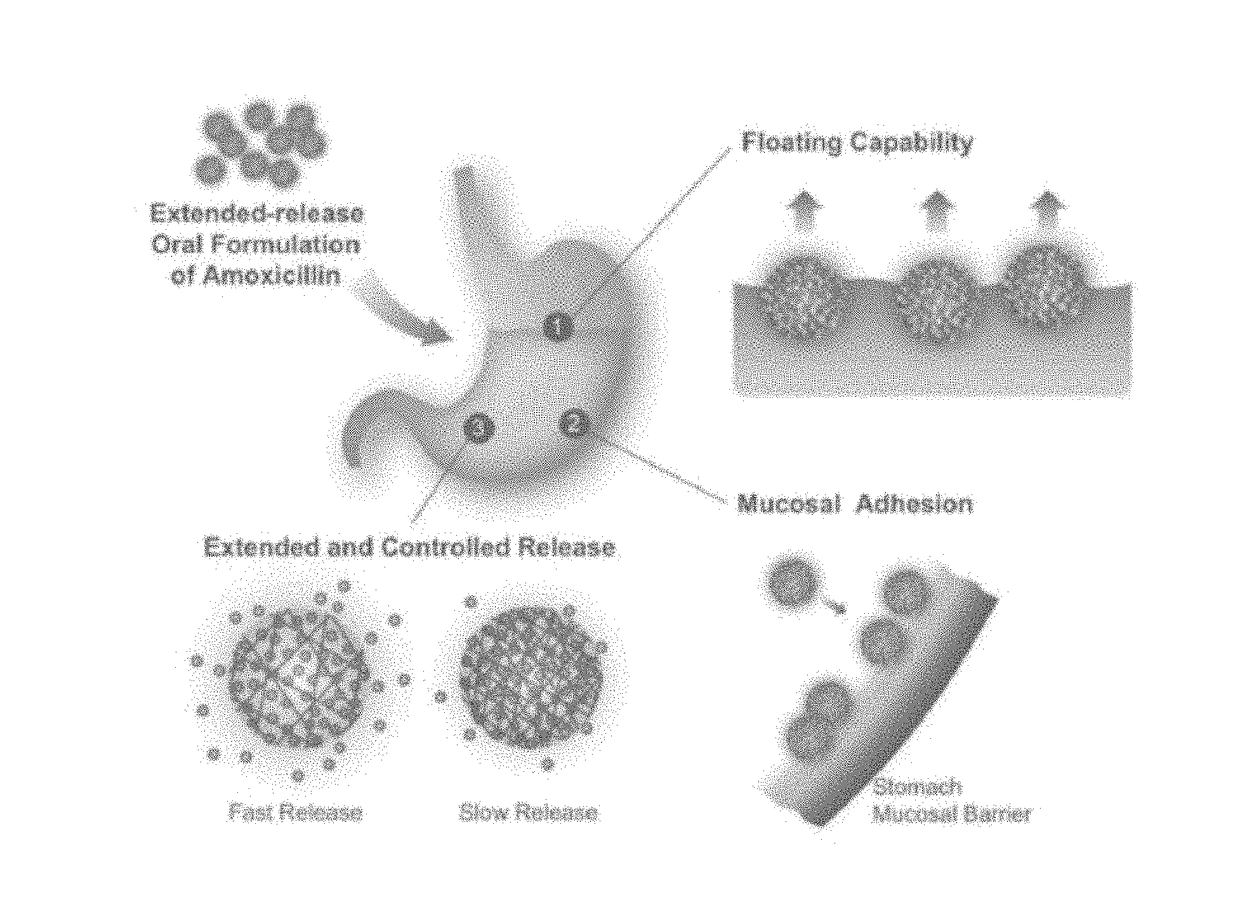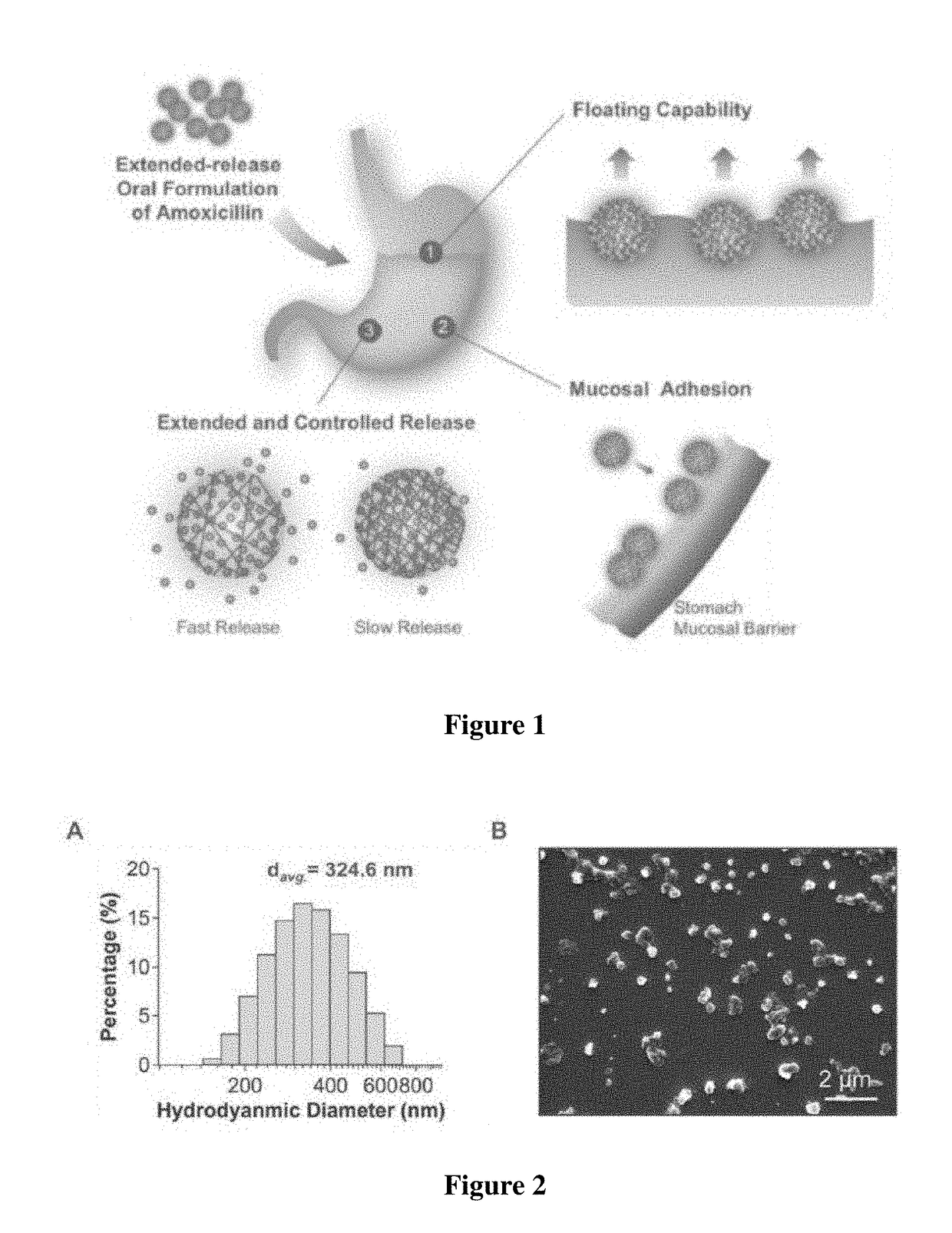Crosslinked nanoparticle composition
a nanoparticle and crosslinked technology, applied in the direction of heterocyclic compound active ingredients, microcapsules, capsule delivery, etc., can solve the problems of i>h treatment, /i>remains a challenging proposition, and the antimicrobial concentration cannot be achieved in the gastric mucous layer or epithelial cell surfa
- Summary
- Abstract
- Description
- Claims
- Application Information
AI Technical Summary
Benefits of technology
Problems solved by technology
Method used
Image
Examples
example 1
Preparing Amoxicillin Nanoparticles
[0043]Chitosan lactate (10 mg, from Sigma-Aldrich), together with amoxicillin (3 mg, from Sigma-Aldrich) were dissolved in water (1 mL) at room temperature. The solution was added with moderate stirring to dioctyl sodium sulfosuccinate (DOSS) and mineral oil or vegetable oil, where the final concentration of DOSS is 5% w / v, and the final concentration of the oil is >75% v / v. Chitosan solution is immiscible with oil and DOSS plays a role in stabilizing the chitosan nanoparticles and crosslinking the chitosan molecules. Then glutaraldehyde (from Alfa-Aesar) was added to the mixture to a final concentration of 5% w / v, followed by immediate sonicating for 30 min to form an water-in-oil emulsion (small water droplets in oil). During the emulsification, cross-linking occurred and nanoparticles formed within small water droplets. Once the reaction stopped, the particles were separated from the suspension by centrifugation (200×g) for 1-5 minutes; the pell...
example 2
Nanoparticle Characterization
[0044]The nanoparticles of Example 1 were re-suspended in water with a concentration of 1 mg / mL. The size and size distribution of the particles were measured by dynamic light scattering (DLS) using the Malvern Zetasizer (ZEN 3600). To further characterize the morphology, a drop of nanoparticle suspension was placed on a silica wafer and then air-dried overnight. The wafer with dried sample on them was then coated with chromium and imaged by scanning electron microscopy (SEM).
[0045]As demonstrated in FIG. 2, the particles have an average hydrodynamic diameter of 324.6 nm and a polydispersity index (PDI) of 0.2 (FIG. 2A). Under the SEM, the dry powder shows a particulate morphology with an average diameter of ˜300 nm, which is consistent with the DLS measurement (FIG. 2B).
example 3
Determining Amoxicillin Loading Yield
[0046]To measure the drug loading yield (drug weight / total weight of nanoparticles), amoxicillin-loaded nanoparticles were formulated following the same procedure described in Example 1 but with different initial drug amounts of 0.1, 1, 2.5, or 5 mg. 1 mg of dried nanoparticles was suspended with 15 mL water. The suspension was stirred vigorously at 4° C. for 12 hours to completely release the loaded drug. Then the suspension was filtered by an Amicon filter tube with a 10 kDa molecular weight cut-off. The amoxicillin concentration in the filtrate was measured and the drug loading yield was calculated.
[0047]As shown in FIG. 3, the amoxicillin loading yield in the nanoparticles increases with the increase of amoxicillin initial concentration. When the amoxicillin input concentrations were 0.1, 1, 2.5 and 5 mg / mL, the corresponding loading yields were determined to be 3.9%, 6.9%, 14.2% and 24.1%, respectively. When the amoxicillin input concentrati...
PUM
| Property | Measurement | Unit |
|---|---|---|
| diameter | aaaaa | aaaaa |
| diameter | aaaaa | aaaaa |
| particle size distribution | aaaaa | aaaaa |
Abstract
Description
Claims
Application Information
 Login to View More
Login to View More - R&D
- Intellectual Property
- Life Sciences
- Materials
- Tech Scout
- Unparalleled Data Quality
- Higher Quality Content
- 60% Fewer Hallucinations
Browse by: Latest US Patents, China's latest patents, Technical Efficacy Thesaurus, Application Domain, Technology Topic, Popular Technical Reports.
© 2025 PatSnap. All rights reserved.Legal|Privacy policy|Modern Slavery Act Transparency Statement|Sitemap|About US| Contact US: help@patsnap.com



